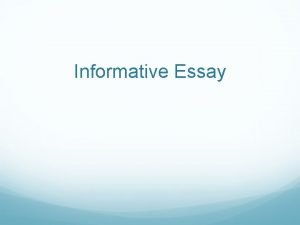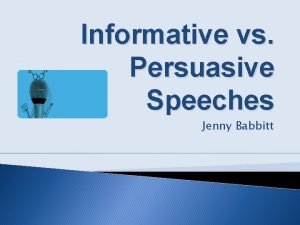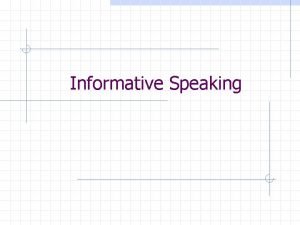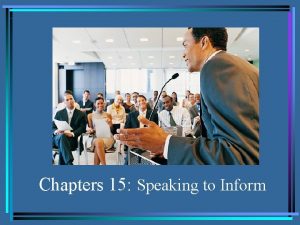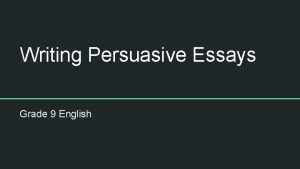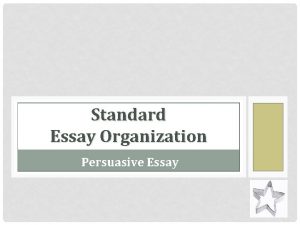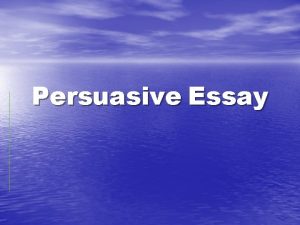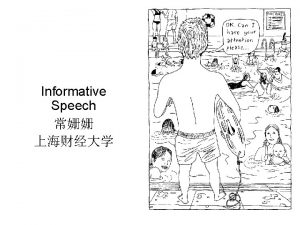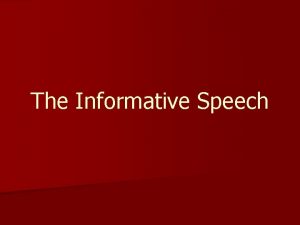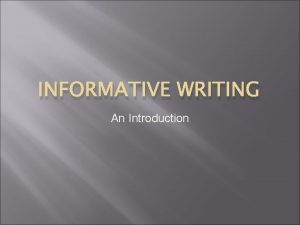Persuasive Essay vs Informative Essay vs English Class








- Slides: 8

Persuasive Essay vs. Informative Essay vs. English Class Research Paper 2016 Component s Persuasive Essay Informative Essay English Class Research Report Introduction • Identify problem (proposition/assertio n) • Introduction of topic • Define the topic Body • Take a stance (pro/con) and generate claims with appropriate evidence to support your stance using a variety of appeals (logos, pathos) Address anticipated challenges to argument • Summarize and organize major findings based on pertinent information Contains facts and information, not personal opinion based on fact with the goal of educating audience. • Identify the information you need to understand the topic Select the best sources Extract relevant data Organize, synthesize, and present information from multiple sources Present final conclusion with the goal of “winning” by persuading your • Make conclusion flow from the facts and synthesis presented in body • • Conclusion 1 • • • Make conclusion (including significance) flow from the facts and

Components of the AP Research Academic Paper Required Element Description Introduction • • Method, Process, or Approach • • 2016 Provides background and contextualizes the research question/project goal and initial student assumptions and/or hypotheses. Introduces and reviews previous work in the field, synthesizing information and a range of perspectives related to the research question/project goal. Identifies the gap in the current field of knowledge to be addressed. Explains and proves justifications for the chosen method, process, or approach. Results, Product, or Findings • Presents the findings, evidence, results, or product. Discussion, Analysis, and/or Evaluation • Conclusions and Future Directions 2 Bibliography • • Interprets the significance of the results, product, or findings; explores connections to the original research question/project goal. Discusses the implications and limitations of the research or creative work. Reflects on the process and how this project could impact the field. Discusses possible next steps. • Provides a complete list of sources cited and consulted in the •

Differences between AP Seminar IWA and AP Research Academic Paper AP Seminar Paper AP Research Skill Needed ✓* Just an Introduction (Literature Review) Finding gap in knowledge base and situating study question/purpose into this gap X Method/Process/ Approach Research Methods-overview and rationale for using such methods X Results/Product/Findin gs How to report findings and connect to research question ✓ Discussion/Analysis/ Evaluation How to evaluate significance of results, including implications and limitations ✓* Conclusions/Future Directions Reflecting on future work Bibliography *Using appropriate style associated with discipline of inquiry introduction of the argument and topic only ✓*3 style not prescribed

AP Research vs. AP Seminar-Differences in Processes and Product ► ► ► 4 2016 Identifying the gap in the current field of knowledge to be addressed Asking a question (that has yet to be answered) Addressing personal assumptions, hypotheses, and/or definitions Situating that question into the larger body of work on that topic Explaining and providing justification for the chosen method, process, or approach for data/information collection and analyses. Coding, categorizing, analyzing, and evaluating that data for its merit in supporting your assumptions and hypotheses pertaining to one’s question.

AP Research vs. AP Seminar-Differences in Processes and Product 2016 Making a conclusion or claim that is a new piece of information or piece of the puzzle, and then finding how it connects to the larger body of knowledge ► Discussing limitations, significance, implications of research ► Reflecting on possible next steps or secondary study ► This process ensures that one who engages in scholarly research is part of the academic conversation (even starting an academic conversation) and not just repeating the parts of the conversation. 5

Bridging between AP Seminar and AP Research 2016 Now that you have engaged in a few lessons pertaining to the inquiry process and choices needed for AP Research, what do you think are skills and concepts students needed to cross from the end of the AP Seminar course to the end of the AP Research course. ► Jot down your ideas on the planks of the bridge ► 6

The Body of Knowledge (what is known) The Phenomenon 7 2016

d Synthe size ne w knowle dge metho Choose aligned tive RQ p effec Develo gap ying a Identif What is the significance and value of your RQ? What method did you use to collect data/information for your RQ? How is your conclusion or new understanding different than what is already known in the field? 8
